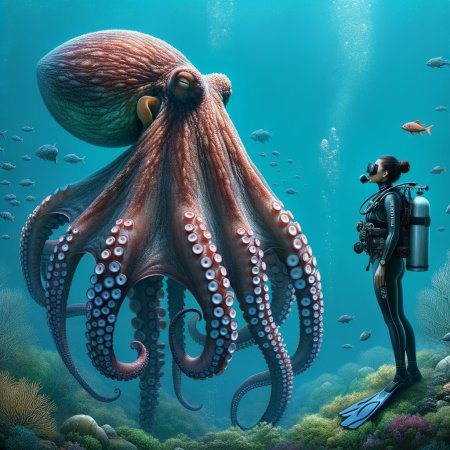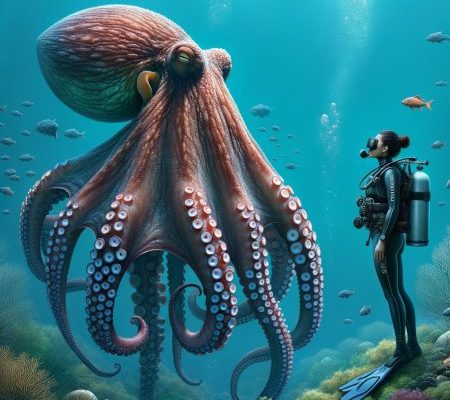
Just picture it: you’re in a serene underwater environment, surrounded by schools of colorful fish. Then, out of the blue, a giant Pacific octopus appears. Its mesmerizing colors shift as it moves, almost like a living piece of art. It’s both beautiful and a bit intimidating. So, can we safely interact with these incredible creatures, or is it best to admire them from a distance? Let’s explore the ins and outs of this captivating underwater relationship.
Understanding the Giant Pacific Octopus
The giant Pacific octopus is a fascinating creature, known for its size and intelligence. These remarkable animals can weigh over 100 pounds and grow up to 16 feet long! They are found in the North Pacific, particularly along the coasts of the United States, Canada, and Japan. Their ability to change color and texture helps them blend into their surroundings, making them expert escape artists.
Octopuses are also incredibly intelligent. They have complex nervous systems, which means they can learn and solve problems. Some researchers even describe their intelligence as comparable to that of dolphins and dogs. This intelligence means they can interact in fascinating ways, but it also raises questions about how safe those interactions are for both humans and octopuses.
Many people are drawn to the idea of swimming with or touching these creatures. After all, they seem so curious and friendly. But the question remains: is that curiosity safe? In the wild, giant Pacific octopuses are typically shy and prefer to flee rather than engage. So while they may seem inviting, approaching them should be done with caution and respect.
The Risks of Interacting with Giant Pacific Octopuses
You might be wondering, what could go wrong when interacting with a giant Pacific octopus? For starters, these animals have strong beaks—similar to a parrot’s—that can bite if they feel threatened. While they’re generally not aggressive, their first instinct is to protect themselves. It’s essential to approach them with care and to understand their body language.
Another thing to consider is the sanitation of the environment. While these creatures are incredible, their natural habitat is filled with various microorganisms. If humans disturb their environment, it can cause stress for the octopus and potentially harm their health. Maintaining a clean and safe space for them is crucial.
You should also keep in mind that octopuses do not handle captivity well. Many facilities that allow human interactions often do not provide the vast expanse that these creatures need to thrive. This can lead to stress for the octopus and affect their well-being. Interactions should always be done in their natural habitat, with minimal disruption.
Best Practices for Safe Interaction
If you’re keen on safely interacting with a giant Pacific octopus, there are some best practices to follow. First, always prioritize the animal’s comfort. If you see an octopus hiding or trying to flee, respect its space. Remember, they prefer to be left alone and are not pets.
Also, consider guided interactions. Some eco-tourism companies offer dive experiences led by professionals who understand marine life. These experts can teach you how to interact responsibly and read the octopus’s body language. Having someone knowledgeable by your side not only enhances the experience but also ensures safety for both you and the creature.
When observing an octopus, try to stay calm. Sudden movements or loud noises can startle them, which might make them retreat. Be as silent as possible, and let them come to you if they wish. This approach often leads to more natural interactions, allowing you to enjoy the wonder of these creatures without causing them undue stress.
Understanding Their Behavior
To fully appreciate the giant Pacific octopus, it helps to understand their behavior. These animals are not only highly intelligent but also incredibly curious. They often explore their surroundings with their arms, using the sensitive suckers to gather information.
When you see an octopus in the wild, watch how it interacts with objects or other creatures. If it’s interested, you might see it reach out with its arms, or it could change color to communicate emotions. By paying attention to these signals, you can gauge its mood and decide whether or not to approach.
Furthermore, octopuses are known to exhibit playful behaviors. They have been observed playing with shells or even interacting with divers in a friendly manner. This playfulness is a testament to their intelligence and curiosity, but it’s essential to let them initiate any interaction.
Choosing the Right Environment for Interaction
The environment where you choose to interact with a giant Pacific octopus matters significantly. The best way to see these creatures is in their natural habitat, such as the coastal waters of the Pacific Northwest. Here, you can find them in their usual rocky dens and underwater landscapes.
If you’re considering a dive trip to experience these octopuses, research the locations beforehand. Look for areas that prioritize ecological preservation and responsible wildlife viewing. This ensures you’re not only having an enriching experience but also contributing positively to the environment.
Many dive tours offer opportunities to observe marine life while minimizing human impact. Choosing such a tour can lead to a fulfilling experience where you can witness the octopus’s natural behaviors without disturbing their habitat.
Conservation and Respect for Octopus Habitats
It’s vital to consider the conservation of octopus habitats when discussing human interaction. The giant Pacific octopus thrives in diverse ecosystems, such as kelp forests and rocky reefs. Protecting these environments ensures they continue to flourish and interact with divers and ocean enthusiasts alike.
You can contribute to conservation efforts by supporting organizations dedicated to marine life preservation. These groups work to protect ocean ecosystems and educate the public about the importance of respecting marine animals. Your involvement can help create a sustainable future for creatures like the giant Pacific octopus.
Additionally, being mindful of your own impact on the environment goes a long way. Simple actions like reducing plastic use, participating in beach clean-ups, and promoting awareness about ocean health can help preserve the habitats crucial to these amazing animals.
Final Thoughts on Human-Octopus Interaction
In conclusion, humans can interact safely with the giant Pacific octopus, but it requires respect, awareness, and knowledge. Understanding their behavior and choosing the right environments for interaction is key. Remember, these fascinating creatures thrive best when left undisturbed in their natural habitats.
Always approach with caution, prioritize their comfort, and appreciate them from a safe distance when needed. By being responsible and respectful, you can enjoy the magic of the giant Pacific octopus while contributing to its conservation. After all, creating a respectful bond with nature leads to the most rewarding experiences, both above and below the waves.

